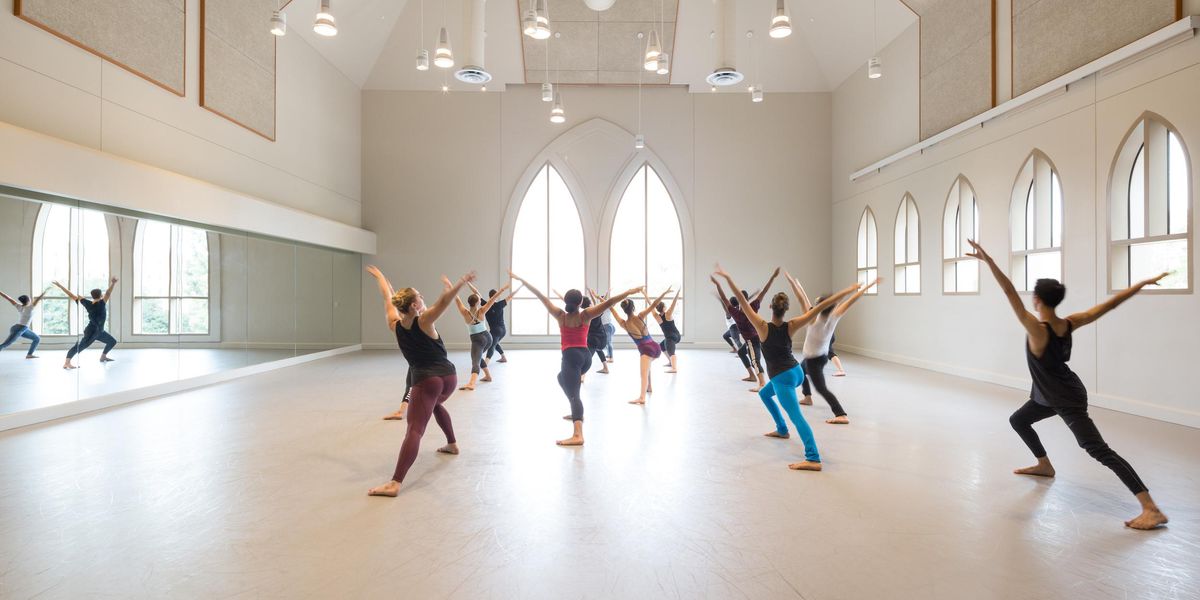The Sounds of Silence
Helen Pickett leads class at The School at Jacob’s Pillow. Photo by Christopher Duggan, Courtesy Jacob’s Pillow.
A dozen women enter the stage slowly, walking backward, defending their bodies with stiffly angled arms. For a full two minutes they take their own paths across the floor, stepping in unison—and silence. Subdued and seemingly desolate, they’re nevertheless united.
The opening of Martha Graham’s 1936 Steps in the Street, created in response to the Spanish Civil War, is a striking instance of the difficult art of performing in silence. For dancers, who are so frequently connected to music, working in silence can pose a unique challenge. Students’ responses to the task range “from terror to excitement to defensiveness to ‘I don’t know what the heck you’re talking about,’ ” says Risa Steinberg, a former Limón dancer and now a teacher at Juilliard. Silence lays the dancer bare—and though that vulnerability is frightening, it can also be powerful. “Silence makes us think more,” says contemporary ballet choreographer Helen Pickett; the vacuum it leaves forces dancers to look deeper into themselves for inspiration.
Perfecting Pacing
When dancers first try performing in silence, it’s often “hard to be slow enough,” says Peggy Lyman Hayes, a master teacher at the Martha Graham School. Without a musical rhythm to guide them—and because balance can become an issue when moving slowly—dancers tend to accelerate. What helps, Lyman Hayes says, is to imagine performing in “absolute slow-motion, like in a dream where you’re trying to move and can’t.”
Sometimes imagining a musical score “accompanying” a silent work can help dancers maintain a consistent tempo. Steinberg ties silence directly to music. “All of José Limón’s works, whether with an actual score or a score of silence, are driven by breath rhythm, so working in silence isn’t a far cry from working with music,” she says. “You’re so trained to be at one with music that if you take that away, you still feel it—still hear it, still conduct it, still play it.” She remembers one “extraordinary experience” with accidental silence while performing Limón’s 1967 Psalm: The music cut out during an ensemble section, but the dancers kept going, and when the music started again, Steinberg says, “We were exactly with it! There’s a thin line between hearing the sound and making it—I don’t mean through noise but through this whole feeling of melody and rhythm.”
Above: Risa Steinberg teaching at Juilliard. Photo by
Peter Schaaf.
Uniting in Unison
Maintaining unison with other dancers without music to orient you might seem next to impossible. Yet listening to “the breath of the bodies around you, the sound of feet on the floor, even the swish of tights and leotards and legs” can help dancers stay together, Lyman Hayes says. “It takes a lot of experimentation, practice, visualization and brain games.” One of those is closing the eyes, which forces dancers to let go of visual cues while “a primitive protective response” opens up the other senses, especially hearing. Tuning in to the breath especially helps. “Sometimes, before a performance, the 12 dancers in Steps will stand together in a circle, their arms around each other’s waists,” Lyman Hayes says, “just breathing together.”
Tapping into Creative Potential
In some ways, working in silence can be freeing. Silence “allows you to be a musician,” Steinberg says. Just as you can “flirt” with Bach, “you can have a playful relationship to the lack of music. There’s the same potential to pull a phrase, drop quickly, suspend.”
Pickett, whose teaching now consists mostly of choreographic workshops, focuses on the creative potential of silence, often used during improvisation. “It’s sometimes easier to sense more possibilities in silence,” she says. “Music can drive a young dancer into what I call ‘the movement machine.’ Movement mindfulness”—which is easier to maintain without the distraction of music—“is a chance to drop further into your art.”
Pickett also teaches in silence at times “to promote a larger sense of hearing,” based on the concept of synesthesia. “Some people can taste words or see movement in color. Touch is also listening; the skin is listening.” When working with music, dancers can be overwhelmed by their auditory sensations. Silence allows them to tune in to these other senses with their bodies.
Pickett believes dancing in silence enhances a sense of personal responsibility in artistic choices. “I use silence to teach students how much creativity they have already,” independent of music, she says. “It’s not something they have to search for.”




